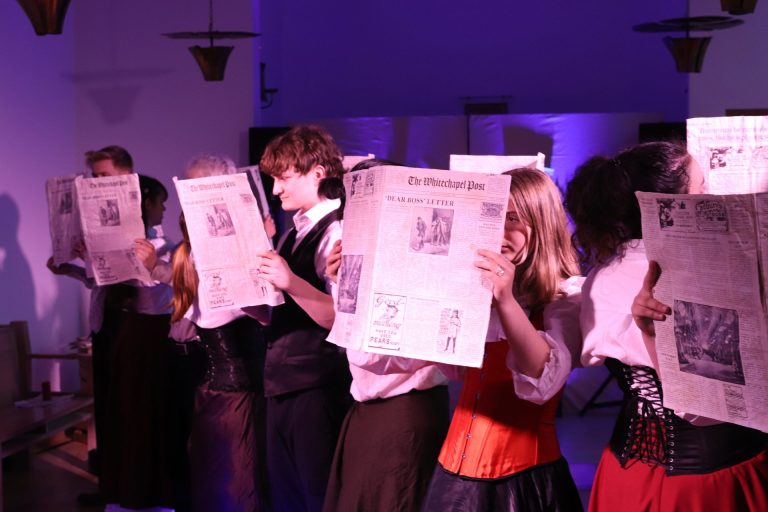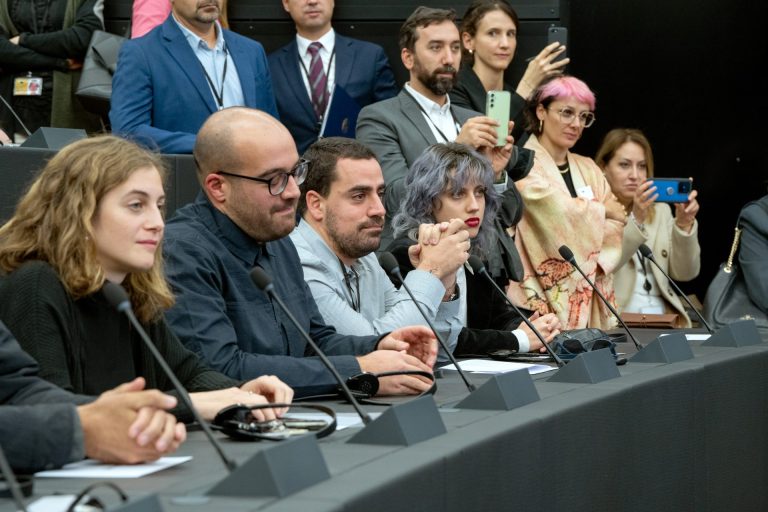CW: Violence
Professor Lady Sue Black, Baroness Black of Strome certainly has a title which precedes her. The President of St John’s made her name as an academic and forensic scientist who worked to identify victims in conflict zones including Kosovo and Sierra Leone, and then later the 2004 Boxing Day Tsunami. I sat down with Sue Black and asked her to give me a “whistle-stop tour” of her life and career which, given an experience which stretches from an Inverness butcher’s shop to the red benches of the Lords, might have been the most difficult question I asked that morning.
First of all, Black paints a picture of someone whose childhood remains an integral part of their story: “I’ve always got stories”, she says. “Both my grandmother and my father were great storytellers, and so everything I have is a story, and it has been really useful for me that as you get older, you get the chance to stop, to turn around, and to look at the life you’ve taken”. Born in Inverness, Black grew up on the Scottish west coast, a native speaker of Gaelic. It is a far cry from the expensively-furnished college quarters where I sit with her now.
Yet that upbringing planted the seed of her future career. “My father, as it happened, was a tremendous shot. I was his little shadow. And so when he would go out shooting [to eat, not for sport, she reassures me], I would carry home the dead rabbits and pheasants. I would sit at the back door with my father and he would teach me how to skin them.”
There was little surprise about a career in forensics, then, when from a very young age, Black “thought nothing of having blood up to my elbows. It felt completely normal”. At thirteen, when her father, ever the Presbyterian, asked her what job she would get, she decided to work in a butcher’s shop. “So when all my friends were selling makeup in the chemists or selling clothes, I was up to my elbows in blood and guts and gore and loved it.”
University wasn’t a consideration until a Biology teacher told her she had to go. “I lied to my parents. I told them I got a full grant, which I didn’t because at the age of 17, I decided that my parents couldn’t afford to support me: total arrogance. So I ran three different jobs at the same time as being in university because I’m not afraid of hard work.”
Once at university, Black didn’t like zoology, genetics, chemistry (“my god”), or botany. But anatomy, that’s just the butcher’s shop: “I walked into the department and knew I was home”. There was never any doubt: “My Biology teacher said I was going to be a scientist, so I had to be a scientist. There was never any doubt about that.”
University came with challenges, though. Black’s parents, while loving, didn’t understand why she needed to go. She adds: “My mother believed I would leave school, I’d get a job in an office, I’d meet somebody and get married, I’d have children, and I’d live five minutes away from her… So when I went and did something different, she cried”. She was proud all the same, Black tells me, but “never understood” what she did for a living.
Black too sometimes wonders how she made it to where she is now: “I still have huge imposter syndrome [that says] my governing body is going to wake up and realise what a mistake they’ve made… so I never get to a point where I think, my goodness me, I’ve really made it.” When I probed to ask whether this makes her a good model for first-gen and state comp students for whom the idea of Oxford seems so alien, she just expresses her amazement at the students who “are all so much smarter than I am. I’ve got here through hard work, not through raw intelligence. You guys just intimidate the living daylights out of me.”
She marvels at the intensity of the eight-week terms, and how people can balance their studies with other roles, whether at Cherwell or any other society. We’ve talked about jobs, so I mention what happened in Kosovo. There, Black was one of the first to work on identifying victims of war crimes committed in the Balkan Wars. Serbian leader Slobodan Milošević later became the first sitting head of state indicted for such crimes.
Shielded by the UN, her team entered across the Macedonian border. Scottish to her backbone, she never realised she was British until she saw the union jack painted on a tank coming right towards them and felt “the sheer sense of relief that says it’s ours”.
That didn’t end the nightmare, though, for their job was to enter a crime scene. 43 dead bodies, people rounded up into rooms “sprayed with Kalashnikov fire”. She tells me that “they [the criminals] stood at the window, threw in straw, threw in petrol, [and] torched the building. [The one survivor] had to lie underneath the dead bodies of his friends and his family who were burning above him because he knew if he came out he would be shot as well.” Black and her team had to return to that scene six months after the event, in 38 degree heat: “a boiling mass of maggots”.
I ask how she can possibly work with such a sense of moral disgust. The solution: block it out. “It’s not your fight. You’re a scientist. Your job is to find the evidence, recover it, analyse it, report on it, and go home. And so I can’t allow myself to empathise and sympathise with those who are present. I can’t allow myself to get angry with those who are responsible. There are other people for whom that is their job, and if I bleed into their job, I’m not being the unbiased, impartial scientist I have to be.” For Black, “all focus is on the courtroom”.
After a lengthy conversation about Kosovo and how it changed her personal outlook, I don’t really see how to proceed from here. How can you ask about such trivial matters as the House of Lords when you’ve just heard about such atrocities? When I ask about the Lords, I expect the usual answer about people being out-of-touch, of not doing real experience in the field, as Black does.
The answer I get, however, comes as a surprise. She recognises the perception of “old people asleep on benches and having a nice lunch”, which she also had on arriving in the role, but claims “that was totally wrong”. She applied after being told that more scientists were needed in the Lords, and more women scientists in particular. “I put my CV in thinking, but it’s not going to happen anyway, so it doesn’t matter.”
Of course, Black was successful and became the Baroness Black of Strome. Perhaps, she claims, it was her disdain for politics and power that landed her the role: “I was interviewed and one of the questions was ‘if you were offered a ministerial post, would you accept it?’ I said: ‘oh, for goodness sake, I couldn’t think of anything worse’. And they all burst out laughing. And apparently that was the right answer.”
“Blown away by the breadth and depth of knowledge” in the House, she believes Crossbenchers in particular can offer important oversight. I press, though: should the Lords be abolished altogether? Surely the system is not fit for purpose, especially with regard to hereditary peers. Black has changed her views on the House, and sees “a genuine commitment to trying to do the right thing”, especially when they sat till 3am to debate the Rwanda Bill, a remarkable feat given the age of some parliamentarians. But of course, she adds, “I suppose if that’s what we vote for, that’s what we vote for. And of course I go with it.”
Black does not vote often (she has no interest or knowledge of football, so why should she vote on it, she asks), but her record is noteworthy all the same. Two which stand out are support for amendments to the Safety of Rwanda Bill and the Elections Bill which opposed the then Conservative government.
Being surrounded by death in her line of work, I figure Black will have some thoughts about the Assisted Dying Bill. She will vote in support, provided she is “convinced that the safeguards are in place”. She highlights the experiences of members of her own family and friends, as well as the importance of autonomy: “I feel that I am sufficiently comfortable with death, that when it is right for me, I want to be able to have that choice.” She cites studies from Ohio, where there is a history of legalised euthanasia dating as far back as 1906. “They’ve had the pill for a very long time”, Black adds, and “over 60% of those who have it don’t take it because [the value is in] knowing they have it.” She again repeats that if the safeguards aren’t sufficient, she will vote against. It may also take a lot of time, since there will be so much scrutiny. On the prospect of the Bill being passed quickly: “I really don’t think that’s a given”.
Having moved quickly through a long career history with just a few stops, I feel obliged to mention St John’s. My own college, and the one Sue Black has presided over since 2022. In part, she tells me, because of the pain that is the West Cost Mainline. It became difficult to do House of Lords work while also living near Lancaster University, where she was Pro-Vice Chancellor for Engagement, and the commuting to London was impractical. A self-described “rainmaker”, Black had her eyes set on bringing in more big projects, which a small university like Lancaster would not necessarily be able to handle.
The application to St John’s came across her desk, and much to her surprise given outside stereotypes about Oxford, “humanity, humility, and a strong moral compass” were the desired qualities. But surely this wasn’t for her, she said, for “they take pedigree”. Why would she have thoughts on the tutorial system when she never went to Oxford?
That honesty carried her all the way to the role. Even bluntness seemed to help. In a video each candidate had to make as part of the selection process, Black said “I feel really sorry for St. John’s, how awful it is to be known as Oxford’s wealthiest college. Wouldn’t it be better to be known as its most welcoming or its most innovative, or its most enlightened, it’s most diverse. Anything has got to be better than being the wealthiest.”
The process was, nonetheless, a long one. “I said to them, you need to understand I’m a Scottish Presbyterian. I’m never going to throw money at anything. So if we’re going to solve problems, we’ll solve them properly. And I thought that’ll be the end of that. And they invited me back again. So I’m thinking by this point, what can I say that’s going to put these people off?” As it turned out, nothing.
I ask her for the weirdest thing she has to do as President.
“Oh, lordy. President of St. John’s College. [Today] I’m going to go away and look at new samples for chairs in the chapel, and then later on in the week, we will go for a perambulation up to Bagley wood, and later on in the summer, we will go and have a perambulation to one of our farms. It’s the most ludicrous job I’ve ever done in my life!”
Searching the crypt in the chapel was another job where Black’s previous experience was useful. “I’ve got responsibility not only for the living, but for the dead on these premises”, she tells me. Fortunately, “it’s the best kept crypt I’ve ever been in my life. And there are seven individuals buried down there, and the crypt is in perfect condition, never needs to be opened again for another a hundred years.”
I warned at the start of my interview that there would be some difficult policy questions, and it was at this point that I shifted my focus to buzzwords in Oxford: AI, free speech, and similar. Having attended the inauguration of Lord William Hague as Chancellor, I too heard him talk up the potential of artificial intelligence as a tool for exceptional change at the University. I ask Black if it’s more of an opportunity or a risk factor.
While “a bit of a dinosaur when it comes to technology”, she notes that AI has changed the face of her own line of work. “We have trained the computers to identify where the hands of the perpetrator are in a video [of child sexual abuse]. I don’t need to look at the video anymore so it can extract the hands. Then we’ve been able to train computers to identify what is the vein pattern on that hand? What is the freckle pattern, the scar pattern, the skin crease pattern, and extract those, convert them into a multimodal biometric… we would never have been able to do manually.”
This, however, is “white box” AI, where the reasoning process is still visible to human engineers. What is more concerning is “black box” AI, where the computer does not show its working. All the same, Black is “supportive of AI in a way in which it will help us to do things that we have not been able to do before, just by the limitation of our own ability. I couldn’t look at 5 million images. I simply couldn’t, but the computer can.” What that isn’t is letting a chatbot write your essay. “Are you cheating yourself when AI writes your essay for you?” she asks – “you are.”
AI done, free speech next. Hague mentioned the Higher Education (Freedom of Speech) Act in his admission address. With a perception in some quarters that higher education needs more protections to ensure that people can speak freely on university campuses, I’m curious to know what Black’s experience across Dundee, Lancaster, and Oxford has shown her.
“I fully believe that people should be able to voice their opinion as long as it is not inducing hatred or aggression of any kind, because we all have our views and it is really the most rewarding of places in a debate, where you have these different views. It’s one of those great human freedoms of being able to listen to a tapestry of perspectives and views, in a way that educates you to come to your own decision.”
“If at any point that freedom is suppressed, then you hear a disproportionate voice. I think we run the risk, with legislation, of altering that dynamic. It’s such a difficult topic because it’s so emotive as well, depending on what you’re talking about. But people should be emotional about things that matter to them, because if they’re not then they don’t matter to you.”
“But as long as you don’t persecute somebody for it, as long as you don’t become aggressive or hateful about it, in a place like Oxford, where there are so many intelligent people, we should be in a position to hold those difficult discussions, with respect for everyone’s perspective.”
“We just need to watch that the legislation doesn’t impact negatively on that ability. But I support it, 100%.” For Black, free speech is a vital enabler of the student experience: “you’re never going to be more critical of institutions than at your age. That’s what being a student is all about!”
With that, I head out to my lecture, and Black switches gear again, to go and inspect new chairs for the chapel.











